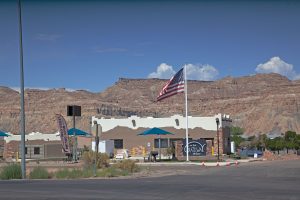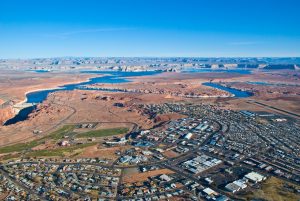Once again the world wide media has descended on Page, Arizona, and Glen Canyon Dam to watch and record a spectacular release of water and witness environmental history.
Starting yesterday and running until March 10, 2008, a high flow water release from Glen Canyon Dam is rushing down Glen Canyon and into the Grand Canyon. This test is identical to the one performed in November of 2004.
The idea behind releasing greater than normal quantities of water, quickly, is to stir up the sediment in the Colorado River beyond Glen Canyon Dam, float the sediment in the water for a short period of time, then slowly bring the water levels back down. The sediment will then settle out onto the beaches and in the backwater areas of Marble Canyon and Grand Canyon. The release of extra water is accomplished by opening the four hollow jet tubes, or bypass tubes, at the bottom of Glen Canyon Dam. Today the dam was releasing 26,500 cfs (cubic feet per second) and will ramp up to a maximum of 41,500 which will be held for 60 hours before ramping back down. In other words, a release of water four times larger than normal, a volume so high that it would fill a 100-story building in about 10 minutes.
Previous high flow experiments have proven rather successful, and the thought is it will be again in rebuilding sandbars and backwater habitat. Lake Powell is expected to drop about 2.3 feet during the experiment, however the yearly outflow will not be affected.
My plan was to go to the dam this morning and take pictures of the outlet tubes with water gushing out of them, but alas, I was unable to get there. I will stop by tomorrow and shoot a couple of photos to upload here.
Glen Canyon Dam stops the flow of sediment down the Colorado River as no sediment gets through the dam. The sediment from the Colorado is deposited at the high end of Lake Powell, 186 miles north of the dam. Since the completion of Glen Canyon Dam in 1966 , the Colorado, which had annual flood and drought cycles, is now a steady flowing river . Without the sediments running down river, the beaches, sandbars and backwaters though the remaining 15 miles of Glen Canyon and the Grand Canyon have disappeared. These high flows stir up the sediment from tributaries below the dam including the Paria River and the Little Colorado.
The first high flow experiment in 1996 was deemed to be successful but was too long, thus causing erosion. The one in 2004 and the one occurring today, are both shorter in duration. When the flooding is over on March 10th, 100 scientists will descend on the Colorado River to monitor, record and map the changes.
Glen Canyon Dam was finished in 1966 and galvanized the burgeoning environmental movement. I spent seven years as a tour guide at Glen Canyon Dam and many of my future blogs will revolve around its place in the west. For more information Google, Lake Powell Flows and click on News. There were 524 articles as of midnight!






